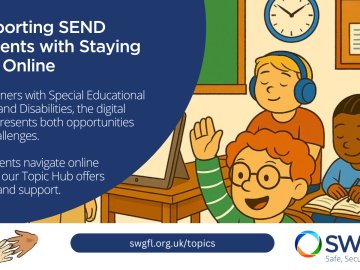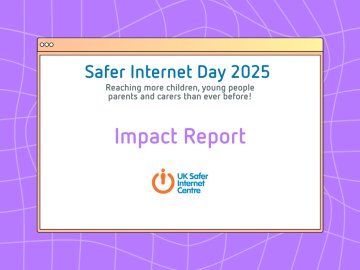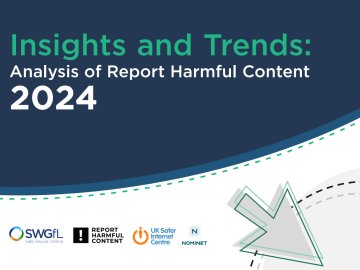At the Professionals Online Safety Helpline (POSH), we have been helping support schools across the UK against harmful accounts and videos posted online, which have been the most common cases reported to the helpline. We have seen instances of students misusing platforms, including TikTok, to create accounts, which may impersonate or reference the school, damaging their reputation, and often bully peers as well as school staff. We want to share important information here about how schools and our helpline can work with TikTok to tackle this issue.
TikTok takes this issue extremely seriously, and our strong relationship with TikTok allows us to report accounts to them directly. These will then be reviewed and removed by TikTok’s Trust and Safety teams. Our helpline, together with TikTok, has played an important role in upholding community standards and supporting victims of online harm.
Escalating to TikTok
The Professionals Online Safety Helpline is able to report accounts to TikTok which may violate its Community Guidelines on a school’s behalf. Below is a list of possible violations to help schools determine what they can report to us. Please note, it is not an exhaustive list and for more details, consult the full guidelines on TikTok’s website.
Click on the buttons below for more information on the most common violations we see.
We can escalate accounts that use a school’s logo as a profile picture.
TikTok makes clear in its Community Guidelines that it does not tolerate members of its community being shamed, bullied, or harassed. Here are some things that meet the threshold for bullying and harassment or hateful behaviour:
- Insulting an individual based on ‘intellect, appearance, personality traits or hygiene.
- Belittling victims of tragedies.
- Wishing harm to another person.
- Sexual harassment.
- Sharing personal information or speculation about a person (e.g., their sexual activity)
- Cyberstalking or ‘trolling.’
- Doxing (gathering and sharing personal information).
- Attacking or dehumanising an individual and using slurs on the basis of protected attributes (Race, nationality, religion, sexuality, gender, gender identity, disease, disability, immigration status).
- Praising or promoting any hateful ideology (e.g. racism), denying well-documented violent events, claiming superiority over other groups.
TikTok is strictly for people aged 13 and over, and it actively removes accounts of people it suspects are under this age. We can report accounts where the users are known to be under 13. This may apply to children in primary school or younger secondary school pupils.
We have seen some other violations of TikTok’s guidelines, although these are less common. These include:
- Threats and incitement of violence
- Impersonation (e.g. of a teacher)
- Violent and graphic content
- Potentially dangerous challenges
- Content encouraging or normalising self-harm, suicide, or disordered eating.
TikTok’s guidelines are clear that this type of content has no place on its platform.
What We Can’t Assist With
There are some accounts which we can report but may not necessarily be in breach of TikTok’s community guidelines:
As highlighted above, impersonation is a violation of TikTok’s guidelines. However, simply using the school's name or photos found on the internet may not meet the threshold for impersonation.
However, if other elements of the account suggest that it is the actual school account – e.g. the content on the account or the account bio – this would be misleading and violate TikTok’s guidelines.
While this sort of content can often be reported, offensive and inappropriate material can be seen as subjective to the user.
Unless we can see a clear violation of TikTok’s community guidelines (e.g. that the content is bullying in nature), we will not escalate the case to TikTok.
Re-sharing or using an image that has already been made public (e.g. on social media or a school website) is not a violation of guidelines or privacy laws, even if done without consent.
They can only be reported if the images are being used to bully or impersonate.
We cannot be the arbiters of truth regarding allegations made against a school or teachers, nor will we attempt to report students for expressing their opinions and, sometimes, criticisms.
We can report content when it becomes abusive or threatening, or is shared with the aim to harass. While we recognise that this has the potential to be damaging at times, it is essential to consider the difference between students voicing their concerns freely (even in a way that can be uncomfortable to read) and bullying or harassment.
Content that talks about or plans 'protests'
Content filmed within a school (unless there is a protection order or safeguarding issue)
What Else Can Schools Do?
Apart from reporting these accounts to us, there are other ways schools can help to prevent and mitigate the situation.
Firstly, it is always important to have conversations regarding bullying and all the different formats this can take. From looking at these accounts, not all of them are trying to be malicious, however, these students may not grasp the ramifications of the content they are posting and the real-life problems they may be causing. This is especially true of accounts mentioning teachers.
It can be seen as easy for students to dehumanise their teachers and disconnect from the fact that what they are doing is bullying as a result. Cyberbullying has many elements that make it easier than conventional bullying, creating a disconnection from empathy and consequences that face-to-face bullying does not share. Emphasising and giving different examples of what constitutes bullying should be included in this education. Young people need to know that something that seems like a joke or an insignificant comment to them may have a severe impact on the victim’s mental well-being.
Schools can liaise with parents and carers regarding the appropriate use of technology. Parents and carers may be unaware that their child has to be 13 to be on TikTok (as well as most social media platforms) and there are a myriad of parental controls they can employ if and when their children get these apps. Provide them with tools and resources so that they can help in combatting and supporting these issues.
You can visit the TikTok Guardian’s Guide for an overview of TikTok and the many tools and controls available to keep the community safe. The guide also provides general information on common internet safety concerns.
Additional Points
Identifying Account Owners
We often get asked if we can identify the creators of these accounts. The answer is no, as TikTok has a strict Privacy Policy it adheres to. However, schools can conduct their own investigations by linking accounts to certain peer groups (e.g., by seeing who interacts with the account). While you are unlikely to be able to confirm who the accounts belong to, you should at the very least have an idea of where to target some interventions.
Reporting Criticisms about Schools
As mentioned, we cannot report accounts just for criticising the school. But a school can attempt to ensure that their pupils (or parents) are less likely to take to social media to air their grievances. Create appropriate outlets and support for them to discuss racism, sexism, mental health, or any other concerns they may have regarding the school.
These are common complaints reported to us that may be valid genuine concerns about the school. Make sure they feel heard and taken seriously. Take a look at the options available to you which can aid in facilitating such conversations with the school community, for example, our Whisper tool allows schools to provide an anonymous reporting route.
Reporting Images
As touched on earlier, we cannot report images or videos which have already been shared publicly. We often get reports from concerned teachers that videos that have been made and shared on the school website are being edited and shared online by pupils.
While this is not usually done to be nasty, if the idea of something being edited and shared is not something that you are comfortable with, consider this when you post something onto a school website or social media.
Unfortunately, we can all lose control over something once it is posted publicly, so keep this in mind and encourage staff to check their social media privacy settings for further support.
Supporting Staff
Ensuring the mental health support of all staff and students is prioritised and looked after is essential. Help equip students and staff with tools to deal with bullying and the sometimes difficult task of navigating an online world.
Do they know how to report and block? Where to reach out if they need to talk? Dedicate time to building up the digital resilience of the whole school community. You can find more information about TikTok’s safety and privacy controls here.
Remind staff that this is a minority of students acting in this manner, and it does not reflect their teaching abilities or take away from the many students, parents, and colleagues who do have respect for them. Take some comfort in considering that this sort of behaviour is nothing new; it’s just taken form in a new way, with a new medium.
Before the days of social media, it would have been the case of passing notes, whispering behind people’s backs, and graffitiing abuse on desks. It can be easy to feel like things are going downhill, but this is not the case and support is always available.




